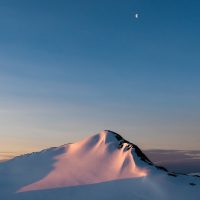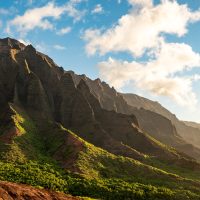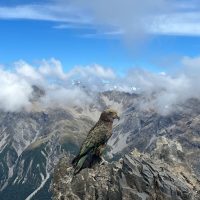The UW Department of Earth & Space Sciences Research Symposium and Gala is an annual graduate student-organized event that brings together students, faculty, alumni and supporters to celebrate our students’ groundbreaking work. This year’s Gala, held during the first week of April, showcased over 50 student presentations, two poster sessions, a department-wide photo contest, an alumni keynote address and an awards reception.
ESS students are exploring the unknowns of our planet and beyond, shaping the future of science. Whether it was an undergraduate presenting a poster for the first time, or a PhD candidate sharing the culmination of years of research, every presentation reflected the passion, curiosity and scientific excellence that defines the ESS community.
“I’m always blown away by the quality of research our students, both graduates and undergraduates, present at the Gala. It makes me feel so proud to be a professor in ESS,” said faculty member Alison Duvall. “The Gala provides a great time to bring our whole community together and see what the different research groups are up to. I use it as an important way to keep up with my colleagues.”
- “Mountain and Moon” by An Li, Juneau Icefield, Alaska
- “Na Pali Ridges” by Paul Morgan, Kalalau Beach, Kauai, HI
- “Heading home” by Charles Fleming, Sonora Peak, CA
- “Mountain Parrot” by Margot Shaya, Arthur’s Pass, New Zealand
These four photos, along with “Accumulation” and “Tufa at the end of the rainbow” (below) are featured in the April “Earth Day” edition of the UW Current, a monthly newsletter.
Photo Contest
From lava flows and ice fields to solar eclipses and parrots on mountain peaks, the Gala Photo Contest is a visual celebration of the Earth and space sciences. The featured images captured not only the landscapes we study, but also the artistry of our students, postdocs, faculty, and staff. Click each photo to expand.
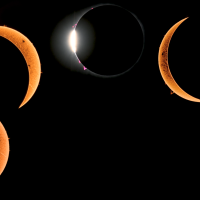 “Golden Lens” 1st Place Winner
“Golden Lens” 1st Place Winner
April 8th, 2024, total solar eclipse, captured in Arkansas, US by PhD students Una Jones, Haskelle White-Gianella, Alysa Fintel, Andrew Shumway, and Assistant Research Professor Baptiste Journaux.
“Silver Lens” 2nd Place Winner
“Accumulation” captured by ESS undergraduate student Matthew Hayes in Kötlujökull, Iceland. It began to snow while Hayes was touring Kötlujökull, an outlet glacier of Mýrdalsjökull. This view greeted him upon emerging from an ice cave.
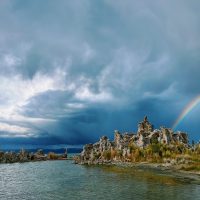 “Bronze Lens” 3rd Place Winner
“Bronze Lens” 3rd Place Winner
“Tufa at the end of the rainbow” captured by PhD student Sophie Johnson in Mono Lake, CA. Tufa (rock that precipitates from water) in Mono Lake, CA, answering the age-old question “What’s at the end of the rainbow?”
Highlighted Sessions and Talks
The breadth of research shared at the Gala is impressive, ranging from geohazards and astrobiology to glaciology and science communication. All the talks exemplified the spirit of the Gala. ESS students not only are learning science but also are using it to connect, challenge and create lasting change. While it’s not possible to capture every talk here, the following highlights offer a glimpse into the range and impact of the work presented.
Best Overall Talk
The “Indomitable Speaker” Award for best overall talk went to graduate student Manuela Köpfli. Manuela’s talk, “Listening to Mount Rainier to Track Ground Moisture” explored the use of fiber-optic sensing to monitor landslide risk in near-surface environments. Manuela reflected on what made the Gala meaningful beyond the presentations themselves: “One of the highlights for me was seeing the diversity of research across the department. Within just a few days, I was able to expand my perspective in ways that no single class could offer–not only scientifically, but also in how we communicate science. It was a great reminder that science isn’t just about results; it’s also about how to craft a story around them.”
Why should we care?
Being able to explain the importance and relevance of your research is a vital skill for any scientist. Graduate student Chris Woodburn won the for best explanation of the relevance of his work, which explores how life might survive on the icy worlds of our solar system. These moons are thought to host vast subsurface oceans, but extreme cold and pressure pose major challenges. Some icy worlds will be explored over the upcoming decade by ambitious, robotic space missions like the NASA Europa Clipper and NASA Dragonfly mission to Titan. It is important that we know how to identify potential biosignatures (chemical signs for life) prior to the arrival of these missions. Chris’s research discovered that a peptide mimic of antifreeze proteins, similar to those that protect fish, vegetables, and other organisms on Earth, can prevent high-pressure ice from recrystallizing. This expands the possible conditions where life might exist. His striking visual images of the growth of high-pressure ice over time are not only helpful in communicating the fundamental concepts of his research, but also capture the imagination. Chris reflected, “it really was a pleasure presenting my research at the Gala, and I’m grateful for all the support I received from the Chemistry and Earth and Space Science departments, and my collaborators at NASA.”
Geologic Hazards & Society

One standout presentation came from graduate student Jess Ghent, whose research takes a human-centered approach to volcanic risk. Her talk, “When Every Second Counts: Parental Decision-Making in Mt. Rainier’s Lahar Inundation Zone,” explored how parents living in communities near Mt. Rainier—like Orting, Puyallup and Sumner—make decisions during emergency lahar evacuations. Lahars, fast-moving volcanic mudflows, can happen with little or no warning due to a volcanic eruption, heavy participation, or landslides. Schools in “no notice” lahar zones have been practicing on-foot evacuation drills, now mandatory and the safest response, for over two decades. However, many parents still intend on retrieving their children by car during such an event, a decision that, while understandable, could put both themselves and others in danger. Using behavioral science and community surveys, Ghent is working to better understand these instincts and help emergency planners build more effective, empathetic communication strategies. Her work highlights an important truth: natural events don’t have to become natural disasters, and preparedness and understanding can save lives. Jess received the “Earth Shaker” Award for best Geologic Hazards & Society talk.
DEI, Outreach & Education

A notable talk came from fourth-year undergraduate Chloe Anderson, whose presentation, “Disaster Dialogue: Interpreting Volcanic Hazards at Craters of the Moon” detailed her summer experience creating an educational talk for visitors at Craters of the Moon National Monument. Initially, Anderson’s depth of scientific knowledge resulted in an overly technical talk for a general audience. She underwent what she described as a process of “ego death,” completely reimagining her presentation. Ultimately, she ditched the PowerPoint and sat on the floor, speaking directly and passionately to her audience about volcanic processes and the importance of understanding geologic hazards. This experience reshaped her approach to science communication and enhanced her ability to engage with the public. Anderson’s journey is a powerful example of how real-world outreach experiences can redefine a student’s skillset, voice, empathy and confidence as a future scientist. Chloe was the recipient of the “Rising Rockstar” Award for best talk by an undergrad.
Another memorable presentation came from graduate student Claire Jensen, who delivered a powerful talk titled, “Geologic History of Black Graduate Students at UW.” In it, Jensen traced the history of Black graduate students in UW’s geology programs—starting with the very first in 1973. Over the last 50 years, only nine Black students have earned graduate degrees in geosciences from UW, with Jensen soon to become the tenth. Through interviews with past students and her own lived experience, she highlighted the systemic barriers that continue to shape diversity and retention in the geosciences. Jensen plans to formally write up her findings to preserve this important piece of departmental and disciplinary history. Claire was given the “Better Together!” Award for best DEI, Outreach & Education talk.

Up-Goer 5
In the Up-Goer 5 session, students must explain their research using only the 1,000 most commonly used words in the English language. These talks are especially humorous and creative.
This year, graduate student Tamara Aranguiz-Rago stole the show and won the “Quick, Quick, Do Tell Me” Award for best Upgoer 5 talk. Her talk, titled “They know your age,” came with music, sound effects and props. In very simple words, she told us about how to pick apatite crystals for thermochronology dating. In her submitted abstract, Tamara writes, “To tell good stories about the world, we need to learn how old things are. This way, we can better understand the past and maybe the present. For people who study the land we live in, it is possible to learn the age of the land using a tiny little piece of rock that has an amazing memory. But what you do not know is that finding those little pieces can be really hard because you not only need to find them, you need to find the BEST ONES. In this talk, I will tell you about how it feels to spend hours trying to find those little pieces and how you can start losing your mind after glaring at them for weeks.”
The winner for this year’s “Is This Real Life?” Award for the best talk relating to a real-world problem, surprisingly came from the Up-Goer 5 session. The prize went to Paul Morgan for his talk titled “Land Slip, Damn,” where he presented a novel method to identify which rivers are most likely to be blocked by future landslides. Paul couldn’t use the word “dam”, which wasn’t on the list, but oddly enough, “damn” was allowed. Using simple terms and striking images and videos of real-world examples, Paul explained how landslides create temporary dams that can flood river valleys for kilometers upstream, and then suddenly fail to produce catastrophic and deadly outburst floods. Mitigation is possible, but only if action is taken quickly—most landslide dams collapse in 10 days or less. To support such planning, Morgan and collaborators are developing a new method they call the “Damability” function for mapping where landslide dams are most likely to form in the U.S. His talk walked through this research using comically misplaced substitutions: “really big cups on big cars” for excavators, “rushing water” for river, and of course “Land Slip” for landslides. However, some of the most used words fit surprisingly well for the study, most notably “Damn.” To summarize his findings in Up-Goer style: The land can slip down and block water, and that can be real bad. We should expect that the land will slip and block some water from going down at some point after now.
Paleoclimate, Paleontology and Sedimentology
This year, Trent Thomas won the “No Bones About It!” Award for best paleoclimate, paleontology and sedimentology talk. He presented his research on the Cryogenian Snowball Earth events: periods of global glaciation that occurred 630-720 million years ago. His talk, “Fundamental aspects of Snowball Earth revealed by a global carbon cycle model”, contained two hypotheses that explain key pieces of evidence related to the Snowball Earth events. First, he showed how a 3-stage mechanism describing the chemistry of the ocean and atmosphere can explain the formation of the massive carbonate layers, called “cap carbonates,” found in the geologic record immediately after Snowball glacial deposits. Second, he showed how chemical processes on the seafloor may be responsible for the observed 14-fold difference in the duration of the Snowball Earth events. Trent also presented this research in an Up-Goer 5 talk titled “Ice Ball World and the Amaze-r of Was,” which followed Ice Ball World’s journey to the Emerald City in search of a method to melt its ice. He reflected, “putting together the Up-Goer talk is always fun because I can express my research very creatively without worrying about getting every detail exactly right – because it’s impossible with only the 100 most common words and five minutes!”
For alumni like Lee Fairchild (Ph.D. 1985), chair of the ESS Advisory Board, the Gala offered a powerful sense of perspective: “This is not the same department that it was when I was a grad student. Everything is different: what people study, how they conduct research, the much higher level of sophistication (I would crash and crater now). All good, just different.” Events like this show how the department continues to evolve while staying rooted in its mission of curiosity and excellence.
How Can You Help?
Behind every inspiring presentation is a network of support that makes student success possible. From funding student research and fieldwork, to expanding outreach and access, to supporting hands-on learning experiences, your gift invests in the next generation of Earth and space scientists. Visit our ESS giving page to explore ways to support our students and the initiatives that matter most to you.
A special thank you to the graduate student organizers for the event – Nicole Aikin, Kunmanee Bubphamanee, Ben Cohen, Alexandra Papesh, and Pete Wynn.

Awards and Recognition
Please see below for a list of the 2025 Gala award recipients.
- “Indomitable Speaker” award for best overall talk – Manuela Köpfli
- “Indomitable Poster” award for best overall poster – Bering Tse
- “Rising Rockstar” award for best talk by an undergrad – Chloe Anderson
- “Rising Rockstar” award for best poster by an undergrad – Sophia Robillard
- “Golden Lens” photo contest 1st place – Ula Jones, Haskelle White Gianella, Alysa Fintel, Andrew Shumway, Baptiste Journaux
- “Silver Lens” photo contest 2nd place – Matthew Hayes – Accumulation
- “Bronze Lens” photo context 3rd place – Sophie Johnson – Tufa at the end of the rainbow
- “Quick, Quick, Do Tell Me” Award for best UpGoer 5 Talk – Tamara Aranguiz-Rago
- “Ice Mastery” award for best Glaciology talk – Margot Shaya
- “No Bones About It!” award for best Paleoclimate, Paleontology & Sedimentology talk – Trent Thomas
- “Earth Shaker” award for best Geologic Hazards & Society talk – Jess Ghent
- “Smarticle Particles” award for best Geophysics talk – Yiyu Ni
- “Better Together” award for best DEI, Outreach & Education talk – Claire Jensen
- “Rocketeer” award for best Astrobiology & Planetary Science talk – Haskelle White-Gianella
- “No Faults Here!” award for best Structure, Petrology & Tectonics talk – Anna Ledeczi
- “Is This Real Life?” award for best talk relating to a real-world problem, application, etc. – Paul Morgan
- “Why Do We Care?” award for best explanation of the relevance of the research – Chris Woodburn
- “Golden Heckler” award for most questions asked throughout the Gala – Dominik Gräff
- “Elevator Pitch-er” award for best poster spiel – Lesly Silva
- “Adam Campbell Best Figure Award” in honor of former ESS who had a knack for catchy figures best exemplified by his Snowball Earth Amoeba”
- Maro Savvides
- Garrett Stromberg
